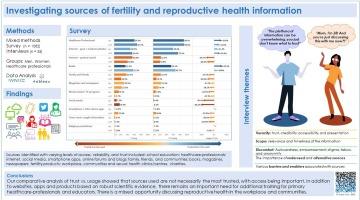A mixed methods study investigating sources of fertility and reproductive health information in the UK |
| |
| Affiliation: | 1. Department of Sexual and Reproductive Health, UCL EGA Institute for Women’s Health, Faculty of Population Health Sciences, University College London, London, UK;2. Faculty of Health, University of Plymouth, Devon, UK;3. Department of Development & Regeneration, University of Leuven, Belgium |
| |
| Abstract: | 
ObjectivesThis study aimed to assess the different sources used by individuals when seeking fertility information in order to understand what’s working, what isn’t, and opportunities for improvement.MethodsA mixed-method study was conducted via UK-wide cross-sectional survey and semi-structured interviews. 1082 survey-participants were recruited nationwide via online-newspaper and social-media adverts. Of those who agreed to follow-up interview, 35 were purposively sampled to reflect the diversity of gender, age-range, ethnicity and education. Tableau software was used for surveys and NVIVO for interviews. Interview data was transcribed and analysed via thematic framework analysis.ResultsSources of information identified included: school-education; healthcare-professionals; internet, social-media, smartphone-apps, online-forums and blogs; family, friends, and communities; books, magazines, newspapers; fertility-products; workplace, communities and sexual-health clinics/centres, charities, and third-party organisations. Participants reported varying levels of access, reliability, and trust, in relation to these sources. Interview themes around veracity showed that healthcare-professionals were highly trusted but not easily accessible. The internet was very popular due to accessibility and perceived anonymity but untrusted, and “the plethora of information can be overwhelming.” There were recurring themes around discomfort. A respondent recalled that her first discussion of sex with her mother was on her wedding night stating, “…Mum, I'm 28! And you’re just discussing this with me now?“ConclusionsSchool education remains a consistent but sometimes inadequate source of fertility information. In addition to online-platforms and products based on robust scientific evidence, opportunities for improvement include using underexploited sources, such as workplace and community settings, with training for providers. |
| |
| Keywords: | Fertility awareness Sources of information Mixed Methods Psychosocial Fertility Education |
| 本文献已被 ScienceDirect 等数据库收录! |
|

